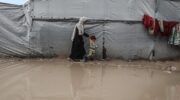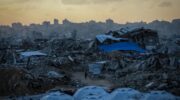Abdul Rahman Shteiwi, 10, was shot in the head by Israeli forces in Kafr Qaddum on Friday, July 12, 2019. (Photo courtesy of Murad Shteiwi)
The Israeli military continues to deny wrongdoing in the case of Abdul Rahman, despite diverse evidence of the opposite. The young boy remains bedridden and immobile while his family struggles to make ends meet…
Reposted from Mondoweiss
It’s been almost three months since 10-year-old Abdul Rahman Shteiwi was shot in the head by Israeli forces in his village of Kafr Qaddum in the northern occupied West Bank.
What was a typical day of Friday protests on July 12 turned bloody when Israeli snipers shot the boy as he was standing at the entrance of his friend’s house in the village.
Since that day, Shteiwi has remained in the Tel Hashomer Hospital in Tel Aviv, unable to speak or move his body.
“The doctors still aren’t sure exactly how much of his brain function has been permanently damaged,” Murad Shteiwi, a relative of the family and local activist in Kafr Qaddum told Mondoweiss.
“He can’t move his hands or legs, he can’t speak. He’s awake, but he can’t do anything,” he said, adding that much of the nearly 100 pieces of shrapnel initially found in the boy’s head are still lodged in his brain today.
Despite accounts from eyewitnesses, activists, and the doctors who treated him all saying that Shteiwi was shot with live ammunition, Israeli forces have maintained that they did not use live fire during protests on July 12th.
“There are several reports done by international organizations that proved Abdul Rahman was shot with a live bullet,” Shteiwi told Mondoweiss. “The Israelis won’t admit it, but there is enough documentation to prove that they shot live ammunition.”
The last reported statement from the Israeli military on Shteiwi’s case was in an August report from the Times of Israel that quoted an anonymous source, saying “the army was investigating, but insisted no live fire was used that day and the boy was not targeted.”
Last month, at London-based research agency Forensic Architecture came out with a detailed report using videos, photos, and eyewitness testimony from the day Shteiwi was shot to piece together a timeline of events leading up to the shooting.
“Contrary to the repeated claims of Israeli officials, the available medical and image evidence, as well as witness testimony, strongly suggests that Abd el-Rahman’s injuries were caused by live ammunition,” the Forensic Architecture report states.
The group’s lengthy report provides evidence of 5.56mm bullets that were shot into a water tank near the clashes, in addition to other bullet casings found in the village.
Discounting claims by the military that Shteiwi was hit with a rubber-coated steel bullet, the group cited forensic experts who said “the level of fragmentation is consistent with fragmentation seen in 5.56 mm rounds. It is inconsistent with the level of fragmentation one would expect to see with a steel-core rubber bullet.”
Notably, Forensic Architecture compared a video of a soldier firing at a protester on July 12 in Kafr Qaddum with a separate video taken at a different location that shows “what the process of firing and reloading rubber-coated metal bullets looks like.”
In the latter video, soldiers can be seen loading rounds into an attachment designed specifically for rubber-coated bullets, whereas in the video taken in Kafr Qaddum, the same actions are “clearly not performed by the soldiers.”
While the Israeli military continues to deny wrongdoing in the case of Abdul Rahman, the young boy remains bedridden while his family struggles to make ends meet.
“His family is in a really tough spot,” Murad Shteiwi told Mondoweiss, adding “they were never well-off to begin with, economically, but things have gotten a lot worse.”
“Abdul Rahman’s father was working in construction before this, but has since had to quit work to stay by his son’s side in the hospital,” he said, adding that the boy’s mother has suffered from multiple heart attacks, one on the day of the shooting, rendering her unable to stay with her son or work to support the family.
For now, Abdul Rahman’s oldest brother is supporting his entire family of seven. “The Palestinian Ministry of Health has offered to pay off all of Abdul Rahman’s medical bills, but the family’s basic income has been affected a lot,” Shteiwi said.
According to Shteiwi, the family has begun the process of filing a suit against the military in court.
“We know the Israeli ‘justice’ system, through our experience, is broken,” he told Mondoweiss, saying “even if the case is clear, and we prove to the court the soldiers were in the wrong, the soldiers will be let off the hook, maybe with a slap on the wrist, if we’re lucky.”
“But if we cannot find justice in the Israeli courts, we will go to the international courts. We must hold these soldiers accountable so that, God willing, Abdul Rahman will be the last Palestinian child to suffer this fate.”
Yumna Patel is the Palestine correspondent for Mondoweiss.





